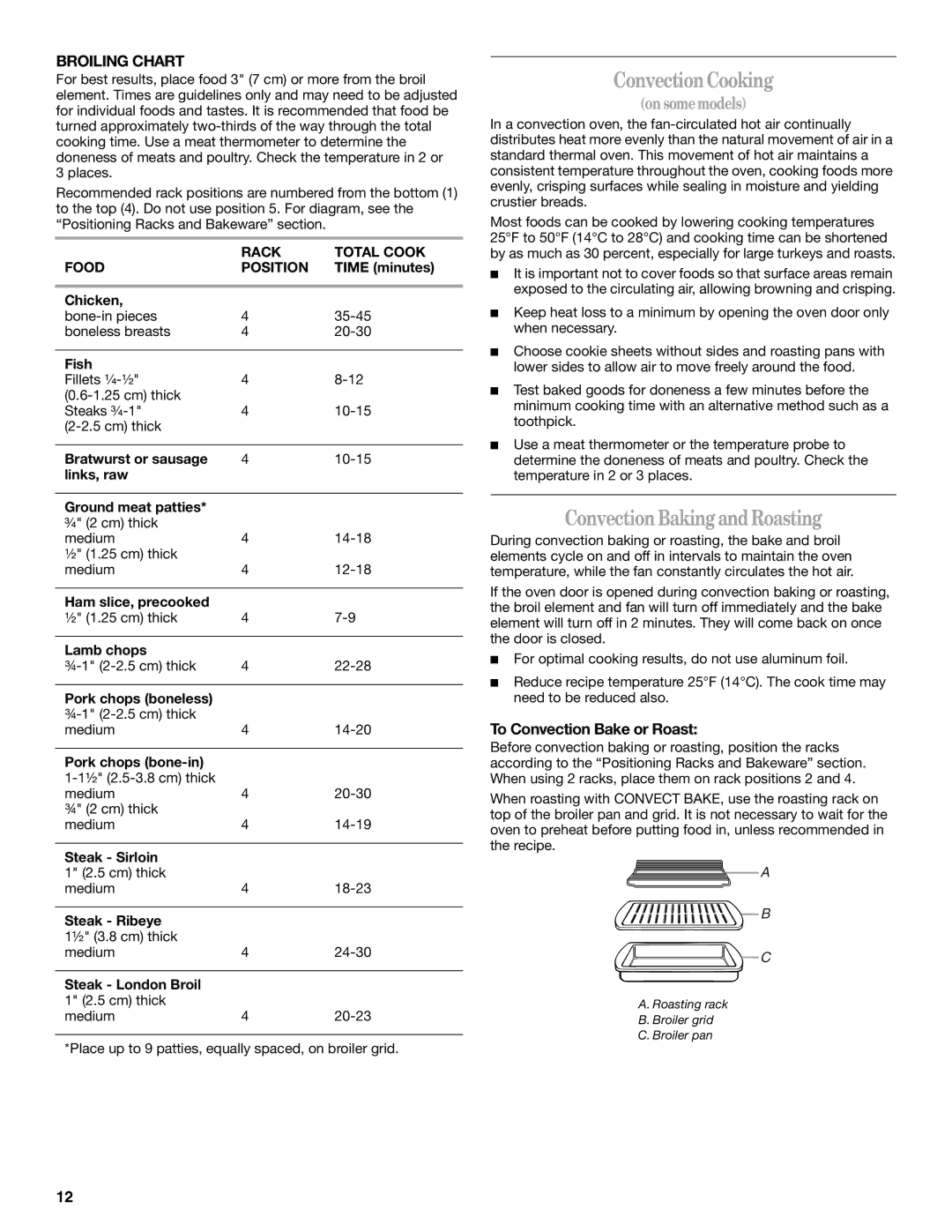
BROILING CHART
For best results, place food 3" (7 cm) or more from the broil element. Times are guidelines only and may need to be adjusted for individual foods and tastes. It is recommended that food be turned approximately
Recommended rack positions are numbered from the bottom (1) to the top (4). Do not use position 5. For diagram, see the “Positioning Racks and Bakeware” section.
| RACK | TOTAL COOK |
FOOD | POSITION | TIME (minutes) |
|
|
|
Chicken, |
|
|
4 | ||
boneless breasts | 4 | |
|
|
|
Fish |
|
|
Fillets ¹₄ | 4 | |
|
| |
Steaks ³₄ | 4 | |
|
| |
|
|
|
Bratwurst or sausage | 4 | |
links, raw |
|
|
|
|
|
Ground meat patties* |
|
|
³₄ " (2 cm) thick |
|
|
medium | 4 | |
¹⁄₂" (1.25 cm) thick |
|
|
medium | 4 | |
|
|
|
Ham slice, precooked |
|
|
¹₂ " (1.25 cm) thick | 4 | |
|
|
|
Lamb chops |
|
|
4 | ||
|
|
|
Pork chops (boneless) |
|
|
|
| |
medium | 4 | |
|
|
|
Pork chops |
|
|
|
| |
medium | 4 | |
¾" (2 cm) thick |
|
|
medium | 4 | |
|
|
|
Steak - Sirloin |
|
|
1" (2.5 cm) thick |
|
|
medium | 4 | |
|
|
|
Steak - Ribeye |
|
|
1½" (3.8 cm) thick |
|
|
medium | 4 |
Steak - London Broil 1" (2.5 cm) thick
medium420-23
*Place up to 9 patties, equally spaced, on broiler grid.
Convection Cooking
(onsomemodels)
In a convection oven, the
Most foods can be cooked by lowering cooking temperatures 25°F to 50°F (14°C to 28°C) and cooking time can be shortened by as much as 30 percent, especially for large turkeys and roasts.
■It is important not to cover foods so that surface areas remain exposed to the circulating air, allowing browning and crisping.
■Keep heat loss to a minimum by opening the oven door only when necessary.
■Choose cookie sheets without sides and roasting pans with lower sides to allow air to move freely around the food.
■Test baked goods for doneness a few minutes before the minimum cooking time with an alternative method such as a toothpick.
■Use a meat thermometer or the temperature probe to determine the doneness of meats and poultry. Check the temperature in 2 or 3 places.
Convection BakingandRoasting
During convection baking or roasting, the bake and broil elements cycle on and off in intervals to maintain the oven temperature, while the fan constantly circulates the hot air.
If the oven door is opened during convection baking or roasting, the broil element and fan will turn off immediately and the bake element will turn off in 2 minutes. They will come back on once the door is closed.
■For optimal cooking results, do not use aluminum foil.
■Reduce recipe temperature 25°F (14°C). The cook time may need to be reduced also.
To Convection Bake or Roast:
Before convection baking or roasting, position the racks according to the “Positioning Racks and Bakeware” section. When using 2 racks, place them on rack positions 2 and 4.
When roasting with CONVECT BAKE, use the roasting rack on top of the broiler pan and grid. It is not necessary to wait for the oven to preheat before putting food in, unless recommended in the recipe.
![]() A
A
![]() B
B
![]() C
C
A. Roasting rack
B. Broiler grid
C. Broiler pan
12
